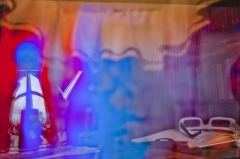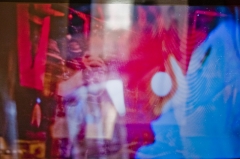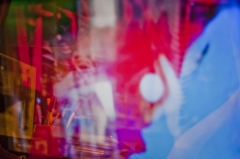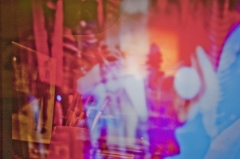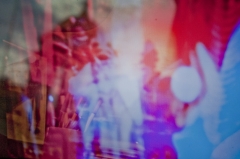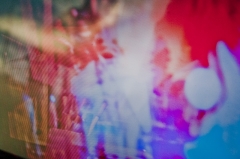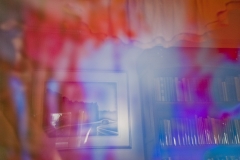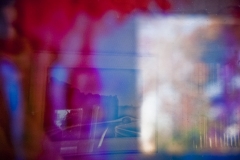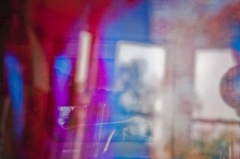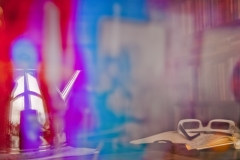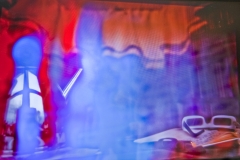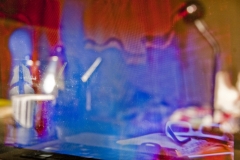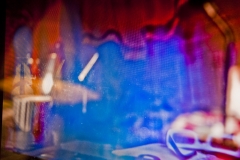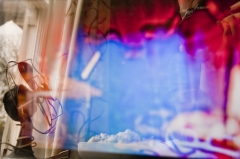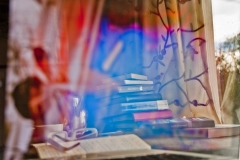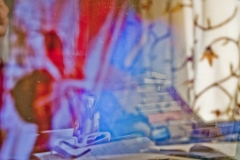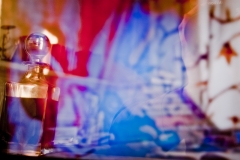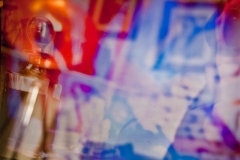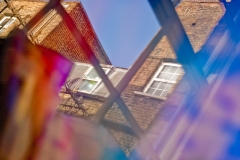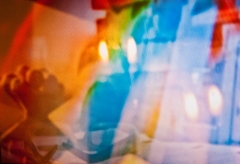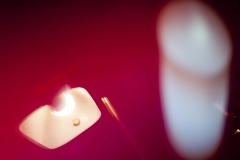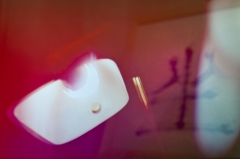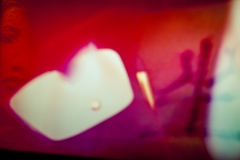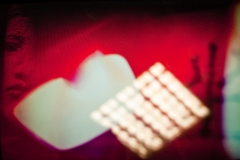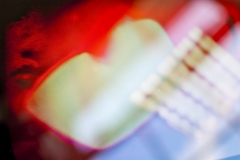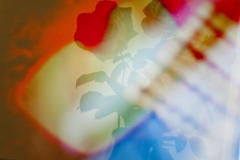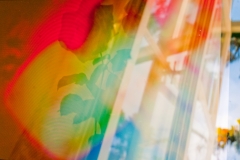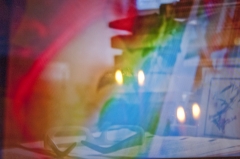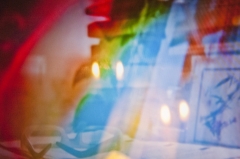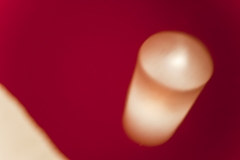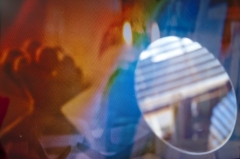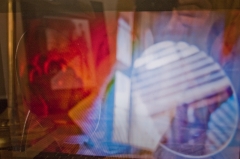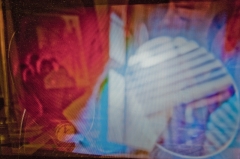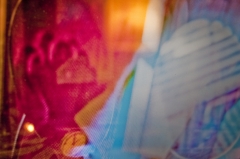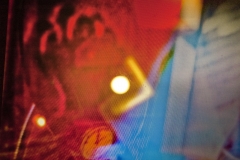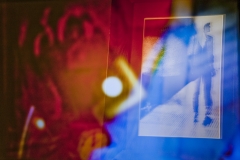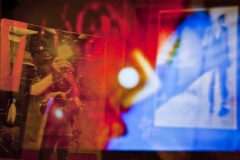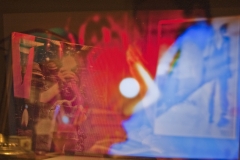In 2010 I took an abstract from a red table reflecting a white light. Since I was longing for everything red, I kept this picture as desktop background. Half a year later, at night, I observed the reflection of my desk lamp on the notebook’s screen which was still showing the very same background. I liked the reflection and took the shot. Once I saw the resulting second picture, I decided to iterate the process to start a series of pictures: By incorporating layers of reflections showing the environment surrounding these pictures, the re-pictured pictures should not only tell where and how they have been viewed but also how they have become the pictures they are becoming.
mirrorical perspective
Reflections are freely observable but prove to be nevertheless elusive. Maybe this is the reason why unearthing them is so intense: The multiplicity of potential perspectives containing all possible views awaits a resolution in our individual choice, such that choosing a perspective becomes a moment of individuation. We are therefore folded into the mirrorical perspective which allows us to look forward onto the object and backward to ourselves. Similarly, when we see an old photograph, we often remember both, the observed scenery we have pictured, and the unshown moment behind the camera we have inhabited. Thus, in connecting the observed world and our inner memories, the picture becomes a bridge between the moment’s actuality and virtuality.
A reflection is showing more than just the reflected object, since it also shows a perspective and a way of looking — and in this sense, a reflection is a quintessential photographic moment: When we look at an object, encircle it, and discover its shape and play with light and color, we see a multiplicity of pictures that could be taken. This moment, when all these virtually possible pictures are present, is the most intense moment of photography. Amidst this tension we choose a shot to turn our vision into an actual picture, and in pressing the shutter release, we let go, releasing not only the shutter but also the build-up having furnished this moment.
The photographic experience is intensified in picturing reflections. First, each reflection is a question of perspective and is often extremely sensible to our position, since a nearby reflecting surface amplifies our movements, such that a difference of some inches is enough to change a reflection entirely. Second, a reflection is — just like any photograph — installing momentary tension that spans from an actual object to a multiplicity of virtually possible reflections. Photographing a reflection is like photographing another picture; and like taking photographs, observing reflections is sometimes not just showing a moment but effectively creating it, inasmuch as this very moment would have never been realized — at least as intensively — without the corresponding insight.
While pictures reflect and reflections picture the world around us and our position within, they also differ in some respects. Reflections have a visible surface with a surrounding context that embeds the reflection. In contrast, pictures frame the world on a mostly clean focal plane and thereby decouple it from its context. When we hang a picture, we often frame the picture to separate it from its environment, giving such a photograph a staged appearance. And most importantly, photographs, once taken, are frozen in time while reflections are still mobile, containing a multiplicity of potential perspectives.
picturing pictures
The pictures of this series have served consecutively as screen backgrounds on my notebook. Each picture shows the preceding one, displayed on screen while reflecting the environment from wherein I was taking the shot. With each subsequent repetition, this environment has been folded into the next picture. In this way, the series has accumulated traces of the past that have either turned into a faint residual shadow looming in the background, or evolved into dominant forces that have been starkly amplified over time. Absorbing their surroundings, these pictures are exceeded by their environments, as much as they are characterized by the process of making them: For example, because they were displayed digitally, the pixelation caused some inevitable moire patterns, especially during shots from angled positions. The colors were also driven into extremes, since strong colors, contrasted by fresh and delicate reflections, became even stronger on the illuminated display. Consequently, these pictures combine their excessively influential environments in a yet individual and characteristic way.
In being re-pictured over and over again, these pictures turned into what they were becoming; and in becoming their own image, they encompass the polarity between picture and pictured. They were part of my environment as the picture I saw most often during the day, while they show simultaneously the very same environment I was living in. Thus, these pictures show the environment they were becoming, and as such, they show what they are. Since photographs usually show not themselves but something else, they are mostly conceived as representations. More than any other art, photography is infused with a mimetic conception that turns photographs quickly into claims on a reality supposedly represented therein. Regardless of whether a representation is achievable or worthwhile to pursue, when we look at a photograph, we still want to believe in seeing something “realistic”. The last 15 years of digitalization have not changed this, probably because a representational ideal is essential to what we consider photography. The pictures of my series, on the other hand, show only themselves, with insisting traces of the environment they were part of. Thus, these pictures do not represent but expose themselves as what they are: They are neither pictured nor picture, they are both.
difference in itself
Some of the pictures were made in quick succession and yield a soliloquy on my surroundings. Listening to our own voice, we experience a slight deferment between the moment when we speak and the moment when we hear ourselves speaking. Likewise, these pictures are deferred, since the composition arising in overlaying picture and reflection becomes — once outspoken, that is, photographed — the condition of the next photograph, just like the word I hear myself saying becomes the condition of the next word I am about to say.
Since each re-pictured picture is different, even if almost no new reflection is overlaid, representational repetition becomes impossible. Instead, this series is propelled forward by a difference in itself. This difference does not occur between one picture and its successor in comparing two self-identical pictures. On the contrary, the difference in itself is establishing the identity of each of these pictures, since there is nothing but change to identify with. These differentially founded identities lead to a repetition of difference, wherein each different picture is conditioning the creation of the next picture that is in turn yet unknown but certainly different. The realization of an actual picture is therefore restructuring the virtual space of potential pictures awaiting actualization.
This process has neither end nor goal. Without any aim to aspire or identify with, the only telos of this series resides in itself. Instead of achieving a preconceived goal (or failing to do so), this series driven by the energy of its inner differences. Without goal, it is impossible to decide which picture to take next, since we cannot establish an outer criterion to establish a decision. All that is left are choices that cannot be explained but only interpreted.
playfulness
My thoughts about this series are infused by ideas of Henrie Bergson (multiplicity, virtuality, and actuality), Gilles Deleuze (difference in itself and the repetition thereof), Jacques Derrida (deferment in soliloquy), and Marcel Duchamp (mirrorical perspective in ready mades). The making of these pictures, however, has been a playful reflection on my surroundings. I collected bits and pieces of my life, included some places where I was a guest, and reflected on the things I was using most of the time. Precisely this playfulness — ironically on a less playful note — links to Immanuel Kant’s notion of the “free inter-play” in the Critique of Pure Judgment, referred to by Bergson and Deleuze. Therein, Kant connects the notion of beauty to a free inter-play between the faculties of mind, which allows us to perceive the world in terms of concepts that do not yet exist, in looking for patterns that establish a concept without having any preconceived pattern in mind. This idea had led over the course of two centuries to virtuality, actuality, and difference in itself.
The series of pictures shown below has accompanied me over time without ever becoming a project, until now, when I have been moving a lot. Living in five apartments in five months, carrying each time all my belongings with me, the perception of my environment has changed: Each new apartment was like another picture that carried in itself the traces of the places I had been living before, thereby manifesting my potential life and conditioning its further course. Above all, it humbled me, showing me that a quiet, peaceful space with my books, some basic practical provisions, and the things that remind me of the love I have received are enough.
